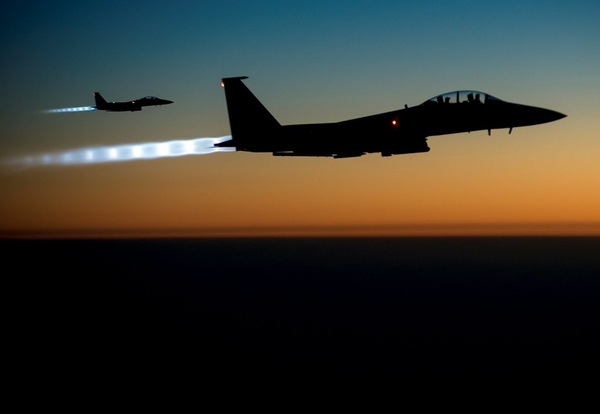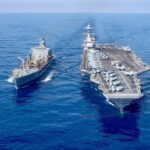
(function(d, s, id) { var js, fjs = d.getElementsByTagName(s)[0]; if (d.getElementById(id)) return; js = d.createElement(s); js.id = id; js.src = “https://connect.facebook.net/en_US/sdk.js#xfbml=1&version=v3.0”; fjs.parentNode.insertBefore(js, fjs); }(document, ‘script’, ‘facebook-jssdk’)); –>
–>
January 17, 2024
The United States has claimed that the air strikes against Houthi military sites in Yemen are not related to the war in Gaza, and are not meant to escalate the regional confrontation with Iran. This should be seen as mere diplo-speak, because not every member of the 22-nation coalition put together by Washington to protect shipping in the Red Sea is on board with shifting from defensive to offensive operations (though most are). The Houthis are explicit in their declarations that they have been attacking both shipping and Israel in support of Hamas, who stated this round of war with its horrific and sadistic October 7 assault on Israeli civilians.
‘); googletag.cmd.push(function () { googletag.display(‘div-gpt-ad-1609268089992-0’); }); document.write(”); googletag.cmd.push(function() { googletag.pubads().addEventListener(‘slotRenderEnded’, function(event) { if (event.slot.getSlotElementId() == “div-hre-Americanthinker—New-3028”) { googletag.display(“div-hre-Americanthinker—New-3028”); } }); }); }
Immediately after the Hamas aggression, the Houthis mobilized their forces in Yemen to support Hamas against the Israeli counterattack into Gaza, Other Iran-backed militia groups across the region also went into action, hitting American bases over 130 times. But the Houthis are the best armed and most fanatical fighters in the Iran network outside of Hezb’allah in Lebanon. They are the Shiite minority in Sunni Yemen, which opened a civil war for control of the country in 2014 when they captured the capital, Sana’a City. This is vital to remember when Iran asserts that the U.S.-UK strikes were “a clear violation of Yemen’s sovereignty and territorial integrity, and a breach of international laws” or when protesters outside the White House claim we attacked Yemen. The Houthis are not Yemen (the legitimate government has moved its flag to Aden), they are a rebel group that controls about a third of the country, which unfortunately includes the Red Sea coast.
China made the connection: “The skewed stance of the US in the Palestinian-Israeli conflict has led to the conflict becoming protracted and caused spillovers.” Russia warned “A large-scale military escalation in the Red Sea region could strike out the positive trends that have emerged recently in the Yemeni settlement process.” This reference is to a UN-brokered truce that has been in effect for nearly two years, renewed in August 2022. A truce which has allowed the port of Hudaydah and the Sana’a airport to operate under Houthi control to supposedly bring in humanitarian aid, but which has obviously been used to supply the Houthis with advanced weapons beyond what is used in the civil war including drones, air-defense systems, and a variety of offensive missiles from Iran. When the truce was first declared in April 2022, the U.S. State Department proclaimed, “Yemenis are demanding peace… the parties should turn their efforts to securing a lasting ceasefire and participating in an inclusive political process.” Yet, the truce has not led to any negotiated settlement. It has only allowed the Houthis to consolidate their position, rebuild, and expand their capabilities, and devise new and expanded strategies for aggression.
 In the months before the truce, the Saudi-led coalition had stepped up its operations against the Houthi. As the UN reported “Recent attacks on the United Arab Emirates (UAE) and Saudi Arabia indicate how the conflict in Yemen risks spiraling out of control. UN Special Envoy for Yemen Hans Grundberg “described the sharp increase in airstrikes, including on residential areas and civilian infrastructure in Sana’a and the crucial port city of Hudaydah… The past month has seen particularly severe shortages in fuel and oil derivatives, notably in areas controlled by Ansar Allah [the Houthi].” So, the truce was meant to save the Houthi, just as demands for a ceasefire in Gaza are meant to save Hamas.
In the months before the truce, the Saudi-led coalition had stepped up its operations against the Houthi. As the UN reported “Recent attacks on the United Arab Emirates (UAE) and Saudi Arabia indicate how the conflict in Yemen risks spiraling out of control. UN Special Envoy for Yemen Hans Grundberg “described the sharp increase in airstrikes, including on residential areas and civilian infrastructure in Sana’a and the crucial port city of Hudaydah… The past month has seen particularly severe shortages in fuel and oil derivatives, notably in areas controlled by Ansar Allah [the Houthi].” So, the truce was meant to save the Houthi, just as demands for a ceasefire in Gaza are meant to save Hamas.
‘); googletag.cmd.push(function () { googletag.display(‘div-gpt-ad-1609270365559-0’); }); document.write(”); googletag.cmd.push(function() { googletag.pubads().addEventListener(‘slotRenderEnded’, function(event) { if (event.slot.getSlotElementId() == “div-hre-Americanthinker—New-3035”) { googletag.display(“div-hre-Americanthinker—New-3035”); } }); }); }
Starting with President Barack Obama, the U.S. gave the Saudi-led coalition logistical support, a supply of weapons, intelligence reports, and aerial refueling for air strikes. In Congress, a coalition of progressive Democrats and a handful of isolationist Republicans charged that the naval blockade had caused “starvation” which in polite circles is now considered unacceptable in modern war. The premier modern strategist Alfred Thayer Mahan discussed commercial blockades as a standard use of sea power. Historians like Andrew F. Smith’s Starving the South: How the North Won the Civil War have studied this strategy, which was also used effectively by the Allies in both world wars. But strategic logic has been pushed off the stage. After the Democrats captured Congress in the 2018 elections, a resolution calling for the U.S. to end all support for the Saudi-led war effort was passed but vetoed by President Donald Trump who had continued support for the Arabs fighting the Iranian proxy in Yemen.
Even before collapsing Afghanistan and opening the door to the Russian invasion of Ukraine, President Biden cut off all aid to the Saudi coalition within days of taking office. This was fully in line with progressive opinion and broke with President Trump’s hardline policy towards Iran. At a February 5, 2021 press briefing, State Department spokesperson Ned Price concluded his review of recent administration statements on Yemen by conceding that “Saudi Arabia faces genuine security threats from Yemen and from others in the region… we’ll look for ways to improve support for Saudi Arabia’s stability, to defend its territory against threats.” This reference seemed like an afterthought given that the focus of Price’s remarks was “ending all American support for offensive operations in Yemen, including relevant arms sales” and ending “our intelligence sharing arrangement with Saudi Arabia and the Saudi-led coalition.” No mention was made about the security of the Red Sea. The Houthis were also taken off the list of terrorist organizations, the reason being given that such a designation would interfere with providing humanitarian aid to Yemen, implying that at least some of that aid would go to the Houthis.
A year later, after the Houthis launched a series of attacks against Saudi Arabia, President Biden had to call King Salman to assure him that the U.S. is “firmly committed to supporting the defense of Saudi Arabia.” The State Department acknowledged “The Houthis have pursued a dangerous pattern of increasingly obstructive and aggressive actions against Yemenis, Yemen’s neighbors, and the international community.’ Yet, the U.S. remained on the defensive until this week, content to shoot down wave after wave of Houthi drones, cruise missiles and for the first time anywhere, ballistic anti-ship missiles. These latter weapons are undoubtedly Iranian weapons based on Chinese designs. Beijing has taken the lead in developing ASBMs for use against U.S. aircraft carriers. China has been supplying Iran with anti-ship missiles for decades.
The State Department has noted the violent connection of Iran, Israel, Palestine, Hamas, and the Houthis. A December 7 press release read “The Iranian regime’s support to the Houthis has enabled unprovoked attacks on civilian infrastructure in Israel and on commercial shipping in the Red Sea and Gulf of Aden. Attacks launched from Houthi-controlled areas have also threatened U.S. warships operating in international waters. Such attacks disrupt maritime security and impede freedom of navigation for commercial vessels, increase regional instability, and risk broadening the conflict between Israel and Hamas.” In its 2022 report on state-sponsors of terrorism, it was noted “Iran continued providing weapons systems and other support to Hamas and other U.S.-designated Palestinian terrorist groups… In Bahrain [headquarters of the U.S. Fifth Fleet], Iran has continued to provide weapons, support, and training to local Shia militant groups… In Yemen, Iran has provided a wide range of weapons, training, advanced equipment such as UAS [unmanned aerial systems], and other support to Houthi militants, who engaged in attacks against regional targets in Saudi Arabia and the United Arab Emirates. On at least five occasions in 2022, the U.S. Navy and partner forces interdicted vessels suspected of traveling from Iran to Yemen, with cargoes that included more than 300 tons of missile fuel components.” Yet, President Biden continued to follow a policy of “restraint” which was not reciprocated. Restraint is the current term used by progressives seeking a “less military-oriented policy” on our part, but not on the part of enemies who see restraint as a form of weakness inviting attack — and attack they have. Yemen is thus a test case for policy failure based on unrealistic hopes that irresponsibly breed wider conflicts. Lessons of history are thus confirmed.
William R. Hawkins is a former economics professor who served on the professional staff of the U.S. House Foreign Affairs Committee. He has written widely on international economics and national security issues for both professional and popular publications.
Image: USAF
<!–
–>
<!– if(page_width_onload <= 479) { document.write("
“); googletag.cmd.push(function() { googletag.display(‘div-gpt-ad-1345489840937-4’); }); } –> If you experience technical problems, please write to [email protected]
FOLLOW US ON
<!–
–>
<!– _qoptions={ qacct:”p-9bKF-NgTuSFM6″ }; ![]() –> <!—-> <!– var addthis_share = { email_template: “new_template” } –>
–> <!—-> <!– var addthis_share = { email_template: “new_template” } –>







